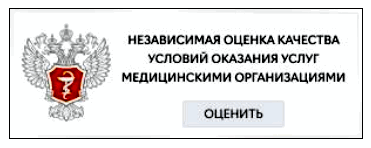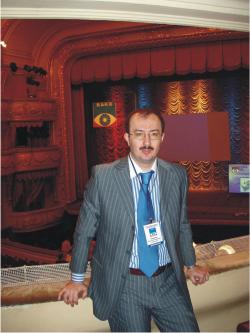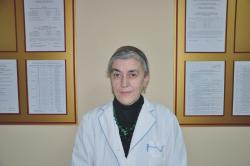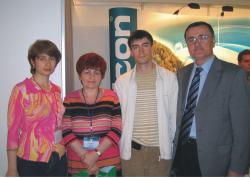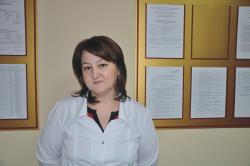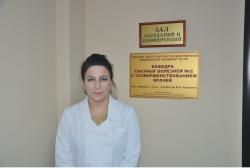Объявления
-
Памятки «Навигатор профилактики», разработанные Московским...
Уважаемые преподаватели и кураторы ФГБОУ ВО ДГМУ Минздрава России! В дополнение к ранее направленному письму от 13 октября 2022 г. № 06-14207/09-18/22 и в...
13.12.2022
2040
-
Список научных и педагогических сотрудников, относящихся к...
Список ППС
02.07.2024
24
-
Как вести себя при обстреле
25.06.2024
78
-
Что делать при угрозе ракетной атаки или обстрела...
25.06.2024
69
-
Новые учебные планы 2024 г.
Лечебный факультет Учебный план 2024-2030 г. Учебный план 2023-2029 г. Учебный план 2022-2028 г. Учебный план 2021-2027 г. Учебный план 2020-2026 г. Учебный план 2019-2025...
25.06.2024
1367
-
Очередное заседание Ученого совета
Уважаемые члены Ученого совета! 28 июня 2024 года в 16.00 состоится очередное заседание Ученого совета на втором этаже в зале заседания (Пл. Ленина, 1).
21.06.2024
185
-
Дайджест возможностей для молодых ученых
Продолжается прием заявок на конкурсы, гранты для поддержки молодых ученых, ниже представлены ссылки на активные конкурсы: Перечень
21.06.2024
69
-
Телефон для приема сообщений о коррупционных проявлениях:
68-32-80
-
Эл. почтовый ящик:
Ubdgmu@mail.ru
Eye Diseases Department №2 with continuing medical education
19.05.2021
249
General information
Head of the Department: Professor Ismailov Muslim Ismailovich
Responsible for the website: Akhmedov Akhmed Magomedovich, e-mail: cross-box@bk.ru
Clinical sites of the department
AMNPO “Center for High-Tech Medicine”
LLC “Eye Clinic” High Technologies”
SBI RD “Republican Ophthalmological Hospital”
DEPARTMENT STAFF
Head of the Eye Diseases Department № 2 with CME, professor Ismailov Muslim Ismailovich
Ismailov M. I. graduated with honors from the medical faculty of the Dagestan State Medical Academy in 1996. From 1996 to 2008, he was promoted from a clinical resident to a professor of the Department of Eye Diseases with a course of continuing medical education of the DSMA (order by FESS No. 849/122-p of April 16, 2008). In 1999, under the guidance of Professor Aliev A-G. D., he defended his PhD thesis on the topic: “A comprehensive method for the prevention of induced aberrations of the optical system of the eye in intraocular correction of aphakia” at the Moscow State Research Institute of Eye Microsurgery. In 2003, with the scientific advice of Professor Aliev A-G. D., he defended his doctoral dissertation on the topic “Eye Microsurgery” at the SI IBSTC named after Academician S. N. Fedorov in Moscow. : “Investigation of the role of aberrations of the optical system of the eye in ophthalmic surgery” (decision of the Higher Attestation Commission of the Russian Federation No. 6d/7 of February 6, 2004). Ophthalmologist of the highest qualification category. Honored Inventor of the Republic of Dagestan (2002). Laureate of the State Prize of the Republic of Dagestan for Science and Technology (2005). Laureate of the international medical grant for scientific work on the problem of dry eye syndrome (Moscow, 2005). Laureate of the All-Russian Competition of Young Scientists (Moscow, 2006). Awarded the honorary badge of the Federal Agency for Technical Regulation and Metrology “Excellent Quality” (Moscow, 2007). Holder of the highest national award of the Russian Federation – the Order of Peter the Great (Moscow, 2008). Member of the Board of the Dagestan Regional Branch of the Society of Ophthalmologists of Russia, member of the Society of Ophthalmologists of Russia, member of the European Society of Refractive and Cataract Surgeons, member of the American Academy of Ophthalmology. He is the author of more than 450 scientific works published both in Russia and abroad, including 1 monograph “Aberrations of the optical system of the eye during artificial lens implantation” (Moscow, 2000), 25 educational and methodological works, 35 inventions. Since 2006 – General Director of the Eye Clinic “High Technologies”. The Government Committee of the Republic of Dagestan for the development of Entrepreneurship and Consumer Market of LLC “Eye Clinic” High Technologies” was recognized as the best small business enterprise in Dagestan in 2008. Since 2010 – General Director of the Autonomous Medical Non-Profit Organization “I. Sh. Ismailov Center for High-Tech Medicine”, which became the clinical base for the newly created Department of Eye Diseases No. 2 with continuing medical education by the decision of the DSMA Academic Council and the Rector order of the DSMA No. 145-OK dated 29.06.2012. The department trains students of medical and preventive medicine faculties, as well as specialists of postgraduate education (clinical interns, clinical residents, graduate students, ophthalmologists of certification improvement cycles). In 2012, Professor Ismailov M. I. was elected head of the department on a competitive basis. In 2015, he was elected deputy of the inner-city district “Kirovsky district “of Makhachkala (DRO of the ARPP “United Russia”) and head of the “United Russia ” faction in the district assembly of deputies. Research interests: diagnosis, prevention and treatment of keratoconus, optimization of surgical treatment of strabismus, chronic dacryocystitis, complex treatment of diabetic retinopathy, features of cataract microsurgery in glaucoma, excimer laser correction of ametropia.
Associate Professor Shamkhalova Elmira Shamkhalovna
She graduated from the Dagestan Medical Institute in 1975. After completing his internship (1975-1976гг.) she worked as an ophthalmologist of the II Urban therapeutic communities of Makhachkala at the Department of Eye Diseases of the DMI. From 1985 to 1989, she studied at the employer-sponsored full-time postgraduate program at the Moscow Research Institute of Eye Diseases named after Helmholtz, with the defense of the thesis of the degree of Candidate of Medical Sciences on the topic <<Long-term results of scleroplasty in progressive myopia and predicting the effect of surgery>> in 1989. Worked at the Eye Diseases Department of the DSMU from 1989 to 2000-assistant, from 2000 to the present – associate professor; is the head of the educational part of the department, secretary of the Dagestan branch of the Society of Ophthalmologists. According to the section of scientific work, he continues to study the problem of progressive myopia. He is the author of more than 60 scientific papers, 3 copyright certificates and patents for the invention of the Russian Federation, more than 20 innovation proposals, teaching aids and recommendations.
Associate Professor, MD Gafurova Larisa Gafurovna
In 1976, she graduated with honors from the Treatment-and-prophylactic faculty of the Dagestan State Medical Institute. From 1976 to 1977 she completed an internship in ophthalmology at the eye department of the Republican Clinical Hospital in Makhachkala. She embarked upon a career in the 2nd Municipal Polyclinic of the 1st city medical association of Makhachkala as an eye specialist. Then she worked as a resident doctor of the eye department of the Republican Clinical Hospital, the Republican Ophthalmological Hospital and Deputy Chief Physician for medical work of the Republican Ophthalmological Hospital. From 1994 to the present, she heads the Republican Ophthalmological Hospital. In 1980 she enrolled in the full-time postgraduate studies in the specialty of eye diseases at the Dagestan State Medical Institute. In 1985 she defended her Ph.D. thesis at the Helmholtz Research Institute in Moscow. In 2000, she defended her doctoral thesis at the All-Russian Center for Disaster Medicine “Protection” in Moscow. Since 2004 she has been an assistant professor of eye diseases at DSMA. Repeatedly passed thematic improvements on eye microsurgery, on urgent conditions in ophthalmology, on topical issues of ophthalmology. In 2015, she underwent an advanced training in ophthalmology on the basis of the ATF HPE DSMA.
Associate Professor Gadzhieva Zariyat Jalalutdinovna
Candidate of Medical Sciences, doctor of the highest category, Excellent Worker of Public Health of the RD, Associate Professor of the Eye Diseases Department No. 2 with of the DSMA. In 1994, she graduated with honors from the Dagestan Medical Academy in the specialty “Medical care”. From 1994 to 1997, she was a clinical resident of the Eye Diseases Department with a course of advanced training of doctors of the DSMU. In 1997, she enrolled in the full-time employer-sponsored postgraduate studies at the Department of Ophthalmology with the course of pediatric Ophthalmology of the Russian Medical Academy of Postgraduate Education, Moscow. In 2000, she defended her PhD thesis on the topic: “Comparative evaluation of various methods of non-specific immunotherapy in the treatment of adenovirus keratoconjunctivitis and their improvement”. Since 2000, she has been working as an associate professor of the Eye Diseases Department No. 2 with continuing medical educationof the DSMU. Author of more than 50 scientific papers, 18 methodological recommendations and 3 innovation proposals. She has advanced training diplomas in “Pedagogy and Psychology of higher school”, “Contact vision correction”, “Ultrasound research methods in ophthalmology”, “Modern methods of diagnosis and treatment of eye diseases”, etc. Gadzhieva Z. D. knows modern methods of diagnosis, treatment of various pathologies of the eye and its appendages. Successfully engaged in teaching and clinical work, consults patients with various ophthalmological pathologies on the basis of ROB and a private medical center.
Associate Professor Magomedov Magomed Aripovich
In 1995, he graduated with honors from the Medical faculty of the Dagestan State Medical Academy. Under the guidance of Prof. Alieva A-G. D. and Assoc. Prof. Maksudova Z. N. completed a clinical residency at the Department of Eye Diseases from 1995 to 1997. From 1997 to 2000, he studied at the full-time employer-sponsored postgraduate studies, at the Department of Eye Diseases of the Moscow Medical and Dental University, where, under the guidance of Professor G. A. Shilkin, he dealt with the problem of retinal and optic nerve pathology. In 2001, he defended his dissertation for the degree of Candidate of Medical Sciences on the topic “The causes of low visual functions in patients with operated retinal detachment with anatomical fit and methods of their rehabilitation”. Works at the Department of Eye Diseases of the Dagestan State Medical Academy: from 2000 to 2013 — assistant, from 2013 to the present — associate professor. Continues to study the problem of retinal detachment. He is the author of more than 30 scientific papers, 20 teaching aids and recommendations.
Head of the advanced training course for doctors of the Department of Eye Diseases No. 2 with CME, Assistant Akhmedov Akhmed Magomedovich
Agmadov A.M. graduated with honors from the medical faculty of the Dagestan State Medical Academy in 2008. From 2008 to 2010, he completed a clinical residency in eye diseases at the Department of Eye Diseases of the DSMU. In 2014, he graduated from the post-graduate program at the Center for High-Tech Medicine. In 2012, he was improved, according to the topic of his dissertation, on the cycle: “Laser retinal surgery and introduction to fluorescent angiography” (ISTC “Eye Microsurgery”, Moscow). In 2015, the technology of retinal pathology treatment developed in the framework of the dissertation research, under the guidance of Professor Ismailov M. I., was awarded a gold medal and a diploma at the international salon of innovations and inventions “Tunis-Innov” (Sfax ). In 2015, Agmadov A. M. was awarded an honorary diploma “For active participation in the innovative activities of the DMA”. He has been working at the Eye Diseases Department No. 2 since September 2014. He is an active participant in the work of the Dagestan Branch of the Society of Ophthalmologists of Russia. In November 2014 he was elected by the cathedral meeting as the head of the advanced training course for doctors of the department. He is the author of more than 50 scientific papers published in Russia and abroad, including 1 Russian patent for the invention “Method of combined treatment of retinovascular macular edema” (No. 2527360), 2 innovative proposals, 1 monograph “Retinal vein thrombosis. Rational approach”, 17 teaching aids and recommendations.
Assistant Huseynova Aminat Magomedovna – assistant of the Eye Diseases Department No. 2 with continuing medical education of the DSMA. In 1996, she graduated from the Dagestan State Medical Academy with a degree in Pediatrics. From 1996 to 1997-internship at the Department of Eye Diseases with the course of advanced training of doctors of the State Medical Academy. After completing the internship, in 1997, she was accepted as a senior laboratory assistant of the Eye Diseases Department with continuing medical education, took part in the organization of the educational process of the Department of Eye Diseases. Since 2013, she has been working as an assistant at the Department of Eye Diseases No. 2 with CME. She is a co-author of scientific papers and methodological recommendations. She has advanced training diplomas in “Pedagogy and Psychology of higher education”, “Contact vision correction”, participant of the 1st World Congress of Optometrists on the topic: “Modern methods of optical vision correction”. Huseynova A. M., owns modern methods of diagnosis, treatment of various pathologies of the eye and its appendages. Successfully engaged in clinical work on the basis of ROB. Consults patients in the”VISUS” optician.
HISTORY OF THE DEPARTMENT OF OPHTHALMOLOGY
The glorious pages of Dagestan ophthalmology are a bright, amazing story of labor and scientific feats, outstanding personalities and wonderful medical teams.
For the first time in Dagestan, the Department of Ophthalmology was founded in 1935 by Professor Haji Omarovich Bulach, one of the initiators and active participants in the creation of the Dagestan Medical Institute in 1932. Haji Omarovich headed the department and the clinic of eye diseases until his death.
Professor Haji Omarovich Bulach (1894-1959) was a prominent scientist, health organizer, and statesman of Dagestan. He was elected deputy of the Makhachkala City Council, deputy of the Supreme Soviet of Dagestan, Deputy Chairman of the Presidium of the Supreme Soviet of the Republic. In 1931, H. O. Bulach brilliantly defended his doctoral dissertation on the topic: “On the morphology of the optic nerve and retina in the light of the research of the Spanish school”. After completing the dissertation, H. O. Bulach receives an invitation from the leadership of Dagestan and the organizing committee to participate in the organization and establishment of a medical institute in the republic. He gladly accepts this invitation and immediately becomes a member of the organizational bureau, and then Deputy Director for administrative work. He agreed to work temporarily in this position, since the first courses of the Institute had not yet organized the departments of histology, much less ophthalmology, where he could work in his specialty. At the same time, his extensive experience in administrative and economic work was used with great efficiency in the creation of the Dagestan Medical Institute. In 1933, H. O. Bulach organized and headed the Department of Histology, and in 1935, as noted above, he created the department and headed the clinic of ophthalmology of the Dagestan Medical Institute.
The high professional qualities of Professor H. O. Bulach as an ophthalmologist surgeon were especially revealed during the Great Patriotic War. During his work in the evacuation hospitals of Makhachkala, his scientific work did not stop. During this period, he published scientific works “Plastic conjunctival sac after gunshot injuries of the eye”, “To the early diagnosis of sympathetic inflammation”, “Gunshot osteomyelitis of the orbit”, “Plastic eyelids with a free flap of the skin of the auricle” and many others. They brought him well-deserved fame as an ophthalmologist. In the post-war years, the public health service of Dagestan was tasked with the complete elimination of trachoma as a mass disease. And Professor H. O. Bulach successfully coped with this task, relying on numerous colleagues and students. By the early 60s, trachoma in Dagestan ceased to exist as a mass disease. Professor H. O. Bulacha is an outstanding teacher who generously shared his knowledge with numerous followers. Under his leadership, 1 doctoral and 6 candidate theses were completed and defended; he published more than 100 scientific papers. Professor H. O. Bulach is the organizer and the first chairman of the Board of the Dagestan Society of Ophthalmologists, which, as a school of professional improvement and exchange of practical experience for ophthalmologists of our republic, continues its activities fruitfully at the present time. Paying tribute to the memory of the organizer of the Dagestan Society of Ophthalmologists, in 1993 the society was given his glorious name.
He was awarded the high titles of Honored Scientist of the RSFSR and Honored Doctor of Dagestan; he was awarded many orders and medals of the USSR. In order to perpetuate the memory of H. O. Bulach, the Council of Ministers of the Republic of Dagestan, by its resolution No. 32 of 22.02.1993, decided to assign his name to the Republican Ophthalmological Hospital. By the order of the rector of the Dagestan Medical Academy No. 35 of 21.02.1993, his name was also assigned to the Department of Ophthalmology of the DSMU. The life of Professor H. O. Bulach, his active life position, high professionalism and internal culture, humanism, selfless service to medicine and the Fatherland are a vivid example for students, young doctors and scientists who have chosen the profession of a doctor.
Since July 1959, the Department of Eye Diseases was headed by Candidate of Medical Sciences, Associate Professor Aishat Isaevna Magomedova. A. I. Magomedova’s PhD thesis “Treatment of purulent corneal ulcers with new antibiotics synthomycin and chlormycetin” was defended at the Moscow Research Institute of Eye Diseases. A. I. Magomedov is the author of more than 40 scientific works. During the struggle with trachoma in Dagestan, she took an active part in it. A. I. Magomedova headed the Department of Eye Diseases until 1971. Currently, Aishat Isaevna is on a well-deserved rest, is keenly interested in the work of the department and the clinic, and is always ready to share her rich clinical experience with her younger colleagues.
Since September 1971, the head of the department was elected Doctor of Medical Sciences, Nikolai Markovich Sergienko, who defended his doctoral dissertation “Research on the theory of clinical refraction of the human eye” in 1970 at the Odessa Research Institute of Eye Diseases named after academician V. P. Filatov. N. M. Sergienko is the author of 5 monographs, more than 300 scientific papers on fundamental problems of clinical refraction and eye microsurgery, has more than 10 patents on various methods of diagnosis and treatment of eye diseases. Currently, N. M. Sergiyenko-Director of the Ukrainian Eye Microsurgery Center, Head of the Department of Ophthalmology of the Institute of Advanced Medical Training, Academician of the Academy of Sciences and the Academy of Medical Sciences of Ukraine. Nikolai Markovich maintains close scientific and purely human contacts with his Dagestani colleagues, is interested in the development of the ophthalmological service, socio-economic and cultural transformations in our republic.
From September 1976 to December 1988, the Department of Ophthalmology was headed by Associate Professor Shamkhal Dibir-Aliyevich Shamkhalov (1924-2001). PhD thesis on the topic: “Methods of formation of a bone hole in dacryocystorinostomy” Sh. D. A. Shamkhalov defended in 1959 at the Moscow Research Institute of Eye Diseases. Helmholtz. He is the author of the monograph “Dacryocystitis”, more than 60 scientific papers; has 6 certificates for innovation proposals, 3 copyright certificates for inventions, 2 methodological developments. Proposed by Sh. D-A. Shamkhalovym instrument for the formation of a bone hole in dacryocystorinostomy is used in many eye clinics in Russia. In the 50s, under the guidance of Professor H. O. Bulach, Sh. D. A. Shamkhalov took an active part in the elimination of the trachoma epidemic in Dagestan. Sh. D. – A. Shamkhalov was a man of versatile talent: an excellent ophthalmologist, a talented musician-composer, a mentor to young people. He has always been in the thick of the scientific and cultural life of the institute: he led the amateur art activities of the Dagestan Medical Academy, organized and until the last days of his life led the vocal and instrumental ensemble of the DSMU “Lens”. Multi-faceted professional social activities of Sh. D. A. Shamkhalova was highly appreciated: he was awarded the honorary titles of People’s and Honored Doctor of the Republic of Dagestan and Honored Artist of the Republic of Dagestan. In 1998, for his contribution to the development of the culture of our Republic, Sh. D. A. Shamkhalov was awarded a high title-the winner of the State Prize of the RD.
Since December 1988, the department has been headed by Professor Abdul-Hamid Davudovich Aliyev. Candidate’s thesis “Research of conditions of rational correction of astigmatism” A-G. D. Aliyev defended in 1980 at the Odessa Research Institute of Eye Diseases named after him. acad. V. P. Filatov. In 1993, he graduated from the Moscow Research Institute of Eye Diseases. Helmholtz A-G. D. Aliyev defended his doctoral dissertation “Aberrations of the optical system of the human eye in normal and pathological conditions and their role in the process of visual activity”. In the same year, he was promoted to the rank of professor.
A-G. D. Aliyev is the author of more than 350 scientific papers, many of which are published in the foreign press; the author of 15 copyright certificates and patents of the Russian Federation for inventions, 10 certificates of the Russian Federation for utility models, more than 40 innovative proposals implemented in the clinical practice of ophthalmological medical institutions in Dagestan, Russia and the CIS. Together with the staff of the department, he has developed more than 15 teaching aids. Under his leadership, the staff of the department and the Republican Ophthalmological Hospital introduced into medical practice more than 50 new technologies for the diagnosis and treatment of diseases of the visual organ. Professor A-G. D. Aliyev is the author of 2 monographs: “Aberrations of the optical system of the eye during artificial lens implantation”, published in 2000 in Moscow (jointly with M. I. Ismailov) and “Thermoelectric semiconductor converters in medicine”, published in 2000 in Makhachkala (jointly with Prof. T. A. Ismailov, Prof. A. I. Khamidov). Under the guidance of Prof. A-G. D. She completed and defended 2 PhD theses (M. I. Ismailov-1999; N. A. Mukhamed-Nur-2000) and 1 doctoral dissertation (M. I. Ismailov – 2003)
In 1994, Professor A-G. D. Aliyev was elected Chairman of the Board of the Dagestan Society of Ophthalmologists, and at the VII Congress of Ophthalmologists of Russia – a member of the Board of the All-Russian Society of Ophthalmologists. Professor A-G. D. Aliyev is a member of the editorial boards of the All-Russian ophthalmological publications-the journals “Ophthalmosurgery” and “New in Ophthalmology”. In 1997, a collection of scientific papers “Actual problems of Ophthalmology” was published under the editorship of A. G. D. Aliyev, dedicated to the 100th anniversary of the birth of Professor H. O. Bulach and the 65th anniversary of the founding of the Dagestan Medical Institute. In 2002 under the general editorship of A-G. D. Aliyev, a new collection of scientific works “New technologies of diagnosis and treatment in ophthalmology” has been prepared for publication, which includes scientific works not only by employees of the Department and the Clinic of Ophthalmology of the DSMU, but also by many ophthalmological clinics in Russia and the CIS. On the initiative of A. G. D. Aliyev, a course of postgraduate education and advanced training of doctors has been opened on the basis of the department since 1990. This made it possible to create a system of training qualified medical personnel, to improve the quality of postgraduate professional education of ophthalmologists of the republic. In 2000 Professor A-G. D. Aliyev was appointed Director of the Dagestan Eye Microsurgery Center by the leadership of the Republic and the Ministry of Health of the Republic of Dagestan. Currently, Professor A-G. D. Aliyev is the head of the Department of Eye Diseases No. 1 with CME.
A prominent scientist, practitioner and organizer of medicine in Dagestan is Doctor of Medical Sciences, Professor Muslim Ismailovich Ismailov. He is the General Director of the Autonomous Medical non-profit Organization “Center for High-tech Medicine” and the eye clinic “High Technologies”, which was opened in 2006. M. I. Ismailov-Honored Inventor of the Republic of Dagestan, winner of the State Prize of the Republic of Dagestan for Science and Technology (2005), winner of the All-Russian competition of young Scientists. Author of more than 400 scientific works, including one monograph, 25 educational and methodological works, 30 patents for inventions. Ismailov M. I. is a member of the board of the Dagestan regional branch of the Society of Ophthalmologists of Russia, a member of the European Society of Refractive and Cataract Surgeons, as well as the American Academy of Ophthalmology. M. I. Ismailov in 1999 ahead of schedule (for 1.5 years instead of 3) under the leadership of Professor Aliev A-G. D. he defended his PhD thesis on the topic: “Complex method of prevention of induced aberrations of the optical system of the eye in intraocular correction of aphakia”. The defense was held at the Moscow State Medical Research Institute “Eye Microsurgery”. After defending his PhD thesis, he continued to work at the Department of Eye Diseases with a course of advanced training of doctors of the DSMA, first as an assistant, then as an associate professor, and finally as a professor of the department. The academic title of professor was awarded by the HAC of Russia in 2008. In 2003, with the scientific advice of Professor Aliev A-G. D. he defended his doctoral dissertation on the topic: “Investigation of the role of aberrations of the optical system of the eye in ophthalmic surgery”. The defense was also held at the State Research Institute of Eye Microsurgery named after Academician S. N. Fedorov in Moscow.
By the decision of the Academic Council of the DSMA and the order of the Rector of the DSMA No. 145-OK of 29.06.2012, the Department of Eye Diseases No. 2 was re-established with the improvement of doctors, headed by Professor M. I. Ismailov.
Scientists and doctors: glorious pages of the department’s history
Dagestan ophthalmology owes its heyday to many doctors and scientists who contributed to the overcoming of eye diseases in Dagestan. Thanks to their selfless work, many tens of thousands of Dagestanis were restored to their lost health. They have worked and are working in different times, different conditions, and even in different eras. But all of them are united by sincere service to people. Without them, it is impossible to imagine the history of Dagestan ophthalmology today.
Assistant Maria Nikitichna Bulach (1918-1984) under the guidance of Professor H. O. Bulach successfully defended her PhD thesis on the problems of prevention and treatment of eye injuries in Dagestan. Everyone who knew and worked with Maria Nikitichnaya remembered her as an energetic and highly erudite specialist and simply as a sympathetic person and a charming woman.
Associate Professor Nariman Gadzhimagomedovich Madiyev under the guidance of Professor H. O. Bulach worked fruitfully and completed his PhD thesis on the problem of early diagnosis and treatment of glaucoma, which is one of the main causes of low vision and blindness. N. G. Madiev successfully combined his ophthalmological work with research and teaching work in the field of health care and social hygiene. Along with Professor H. O. Bulach, Associate Professor N. G. Madiev took an active part in the organization and work of the Dagestan Society of Ophthalmologists, for many years being the secretary of the society.
Associate Professor Nabi Nurmagomedovich Huseynov (1925-1996) devoted his scientific activity to the problem of studying complications of the visual organ in brucellosis infection, successfully completing his PhD thesis on the topic “Brucellosis and the eye” in 1953 at the Stalingrad Medical Institute. N. N. Huseynov is the author of more than 50 scientific papers, teaching aids, and innovation proposals. For many years, the colonel of the medical service, associate Professor N. N. Huseynov, devoted himself to the military medical service, working with dignity and honor in various regions of our country and abroad. Working in senior positions of the military medical service, Nabi Nurmagomedovich proved to be an experienced organizer and a highly qualified specialist. For his services to the fatherland, N. N. Huseynov was awarded many orders and medals. Nabi Nurmagomedovich Huseynov remains principled, responsible, punctual, strict and sensitive in the memory of colleagues, friends and patients.
In the prime of his creative powers, the life of Associate Professor Elbert Hadzhievich Bulach (1941-2000) was cut short. The PhD thesis of E. H. Bulach is devoted to the study of the histochemical and biomechanical properties of the scleral capsule of the eye in progressive myopia (1971). The results of these studies were carried out at the Moscow Research Institute of Eye Diseases. Under the guidance of Professor E. S. Avetisov, they were the theoretical basis for the widespread use in ophthalmology of surgical methods for the treatment of progressive myopia. Associate Professor E. H. Bulach made a great contribution to the creation of the Faculty for working with foreign students of the DSMU, first as the dean, and then as the vice-rector of the DSMU. Balanced, friendly, intelligent, always ready to come to the aid of the sick and the needy – this is how everyone remembers E. H. Bulach.
Professor of the Department Zaira Abdul-Malikovna Makhacheva studied in clinical residency, postgraduate and doctoral studies at the ISTC “Eye Microsurgery” under the guidance of S. N. Fedorov. In 1985, at the ISTC “Eye Microsurgery”, she defended her PhD thesis on the topic: “The state of the eye hemodynamics in patients with proliferative diabetic retinopathy before and after vitrectomy”. In 1994, she defended her doctoral dissertation “Anatomical and functional justification of surgical interventions on the vitreous body in vitreous destruction”. Professor Z. A. Makhacheva is the author of more than 70 printed scientific papers, 5 copyright certificates and patents of the Russian Federation for inventions, 13 innovation proposals, 10 teaching aids and educational videos. In 2001, Professor Z. A. Makhacheva, in collaboration with L. A. Avanesova, published an educational and methodological manual “AIDS and the eye”, recommended by the EMA Ministry of Health of the Russian Federation as an additional reference and information literature for medical workers and students.
Associate Professor of the Department Grigory Naumovich Gitelman at the Moscow Research Institute of Eye Diseases. In 1969, he defended his PhD thesis on the topic: “Comparative evaluation of diagnostic methods for oculomotor lesions and the use of the principles of cybernetics for this purpose”. He is the author of more than 50 scientific papers, 1 patent of the Russian Federation for an invention, 9 innovation proposals, 6 teaching aids for students and practitioners. Associate Professor G. N. Gitelman is a consultant and curator of the Republican Cabinet for the Protection of Children’s Vision, advises and shares his experience in the treatment of oculomotor pathology with young colleagues.
Associate Professor of the Department Elmira Shamkhalova at the Moscow Research Institute of Eye Diseases. Helmholtz defended (1989) her PhD thesis on the topic: “Long-term results of sclerotic strengthening operations in progressive myopia and forecasting the effect of operations”. He is the author of 40 scientific papers, 3 author’s certificates and patents for inventions of the Russian Federation, more than 20 innovation proposals, 7 teaching aids and recommendations. He is engaged in studying the problem of progressive myopia. Takes an active part in the work of the Dagestan Society of Ophthalmologists, being the executive secretary of the Society.
Associate Professor of the Department Zaira Nabievna Maksudova at the Moscow Research Institute of Eye Diseases. Helmholtz defended (1994) her PhD thesis on the topic: “Some features of the dynamic refraction of the eye in laser refractometry and its use to refine optical correction”. He is the author of more than 30 scientific papers, methodological recommendations on the use of the laser refraction analyzer LAR-2 (together with Professor Yu. Z. Rosenblum). Deals with the problems of using low-energy lasers in the diagnosis and treatment of eye diseases. Successfully combines academic work with practical medicine, being the deputy director of the State Institution of SPA “DCEM” for organizational and methodological work.
Assistant Erike Ilyasovna Dolgatova at the Moscow Research Institute of Eye Diseases. Helmholtz defended (1992) her PhD thesis on the topic: “Diagnosis and clinical and morphological picture of brucellosis of the eye”. He is the author of more than 30 scientific papers, 1 monograph, 28 innovation proposals, more than 10 teaching aids and recommendations. He is engaged in studying the problem of etiological immunodiagnostics and immunotherapy of inflammatory eye diseases.
Assistant Zaira Nutsalkhanovna Akhmedova at the Academy of Postgraduate Education in Moscow defended (1993) her PhD thesis on the topic: “The organ of vision in the conditions of surgical correction of severe forms of diabetes mellitus”. He is the author of more than 20 scientific papers, 5 rational proposals. He is engaged in the study of modern methods of diagnosis and treatment of visual organ lesions in diabetes mellitus.
Assistant Zariyat Jalaludinovna Gadzhieva at the Academy of Postgraduate Education in Moscow defended her PhD thesis (2000) on the topic: “Comparative evaluation of various methods of non-specific immunotherapy in the treatment of adenovirus keratoconjunctivitis and their improvement. He is the author of more than 10 scientific papers, methodological recommendations and innovation proposals.
Assistant Magomed Aripovich Magomedov in the ISTC “Eye Microsurgery” defended his PhD thesis (2001) on the topic: “The causes of low visual functions in patients with operated retinal detachment with anatomical fit and methods of their correction”. Author of more than 25 scientific papers, teaching aids and recommendations.
Kaya Suleymanovich Kayaev graduated from the residency in ophthalmology in 1991. Currently, he works as a resident of the State Institution of SPA “DCEM” and heads the scientific and clinical laboratory of the department. He is the author of more than 10 scientific papers and innovation proposals.
Senior laboratory assistant Aminat Magomedovna Huseynova in 1998 graduated from an internship in ophthalmology and received a certificate of an ophthalmologist. She takes a direct part in the organization of the educational work of the department.
Next to those who today continue the best traditions of the Department of Ophthalmology of the DSMU with their daily work, young forces reach new heights hand in hand with their senior colleagues and mentors, whose names will undoubtedly appear on new pages of the department’s history. The history of the Department of Ophthalmology of the Dagestan Medical Academy continues …
LLC “Eye clinic ” High technologies”, Makhachkala
In the last decade, one of the most acute problems that require adequate solutions by the state and society is the dissatisfaction of the population with the level of medical care received and its availability. One of the reasons for this is the lack of resource provision, which, reducing the level of the material and technical base of medical institutions, inevitably leads to a deterioration in the quality and availability of medical care.
Today it is obvious that in the conditions of low level of financing of health care, state guarantees in the field of health care are excessively high. The system of compulsory medical insurance (CMI) solved the problems of the health crisis and provided material support for guarantees for providing free medical care to the population.
At the same time, the need for continuous development and improvement of medical technologies and, accordingly, maintaining a decent level of medical care for broad categories of the population requires the attraction of additional funds and the search for alternative mechanisms for providing resources to the industry.
The most primitive option for obtaining additional funds in public health institutions is the organization of paid medical services. This requires the separation of patient flows with the allocation of self-pay patient of a separate budget of working time and medical equipment. However, observations have shown that the level and quality of medical services provided to self-pay patients and free patients is practically no different, and the doctor is interested in serving, first of all, a self-paid patient. As a rule, the entire volume of paid services is reduced to providing only conditions of “enhanced comfort” in the hospital. Such a strategy of implicitly replacing free medical care with paid medical care, naturally, causes an increase in discontent among the population insured under the CMI and forms a negative opinion about the CMI system as a whole.
The Presidential Program – a Priority National Project in the field of healthcare-on the one hand allowed additional funds to be raised in healthcare, but on the other hand led to the emergence of a new phenomenon – an absolutely unjustified distribution of material and technical resources and, as a result, the formation of deliberately unrealized medical services on the territory of an administrative subject.
Another source of additional funds is voluntary health insurance (VHI). But there are also certain problems here. Often, without any insurance risk, the VHI contract is issued in the registry of the health care facility, being in fact a tool for the implementation of ordinary paid medical services. The most appropriate option for the development of the VHI system is to participate in joint programs with the CMI by paying for part of the medical care that exceeds the guaranteed minimum.
In recent years, the problem of introducing new high-tech methods of diagnosis and treatment into clinical practice has been increasingly discussed. The existing federal quotas for receiving medical care in specialized central research institutes are sorely lacking and they are unable to cope with the actual need for such services. The Federal Agency for High-Tech Medical Care (Rosmedtechnology) has been created to solve this problem of ensuring the availability of modern medical care. It is planned to create new centers in the future, which will also work under quotas. But high-tech medical care is needed today, and many people still do not have access to it.
The two-year experience of successful work has shown the most promising, in our opinion, model of organizing high-tech medical care for the population in the conditions of mandatory medical insurance. This model of organization of non-state health care facilities in the Republic of Dagestan is implemented in LLC “Eye Clinic” High Technologies”.
The basis for the creation of a non-state health care facility is to attract investments, funds from enterprises, insurance companies, charitable organizations or personal funds of citizens who can act as its co-founders. Naturally, such clinics are equipped with the most modern and high-tech medical equipment that allows you to comply with all diagnostic, medical-technological and medical-economic standards of medical care. The organization of financing of a non-state clinic, in addition to the founding council, is within the competence of the executive authorities of the subject of the Russian Federation, the territorial divisions of the Federal Fund of Compulsory Health Insurance and medical insurance organizations that carry out mandatory medical insurance, and implies a mechanism for the patient’s complicity in paying for services. By the decree of the Government of the subject of the Russian Federation, this medical institution is included in the register of medical institutions that implement the program of state guarantees to provide the population with free medical care. The territorial fund of the CMI approves the expected volume of implementation of state guarantees – the so-called state (municipal) order. After that, a contractual relationship is concluded with the insurance company that directly implements the CHI program in the region.
In this model, when receiving medical services, the patient enters into a contract with the clinic for the provision of medical services on the terms of an additional payment under the CHI. At the same time, he pays the amount approved by the price list, which is a certain part of the funds necessary for a full examination and treatment of the patient in compliance with the most modern standards of medical care. At the same time, the contract clearly states that absolutely all the necessary state-of-the-art medicines and services (accommodation in a hospital, provision of soft equipment and high-quality food in full), i.e. the so-called “protected” articles, are provided to him free of charge (under the CMI policy). And the patient pays only a part of the funds in excess of the approved territorial CMI program, which are necessary for medical institutions to compensate for the costs of depreciation and maintenance of unique medical equipment, the purchase of expensive consumables, etc.
The introduction of co-payments (surcharges) of citizens at the time of their consumption of medical services has allowed us to significantly improve the quality of medical care by improving the provision of more effective medicines, more technologically advanced medical equipment, increasing the comfort of hospital stay, as well as increasing the personal responsibility of the patient for their own health. At the same time, the introduction of co-payments is a great responsibility for the personnel of the MPI due to the need for strict compliance with all medical and professional standards, since this responsibility is also clearly and clearly spelled out in the contract concluded between the patient and the MPI.
In the further improvement of professional standards, an important role is played by the creation of advanced training departments on the clinical basis of a non-state medical institution. Thus, the advanced training course for doctors of the Department of Eye Diseases of the DSMU, created on the basis of the eye clinic “High Technologies”, is a center for professional training and retraining of specialists-ophthalmologists of the RD.
Thus, to improve the efficiency of medical and economic activities of healthcare, we have developed and implemented on the basis of a non-state ophthalmological clinic an effective model for organizing the activities of a medical institution in a subject of the Russian Federation, as the most rational, in our opinion, option for solving the problem of insufficient resource provision of the industry and ensuring the availability of high-tech medical care to a wide segment of the population.
